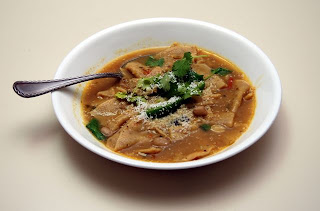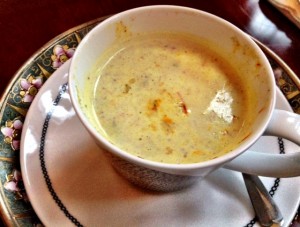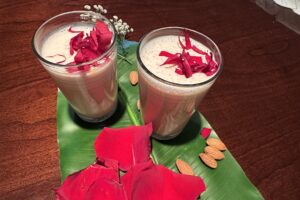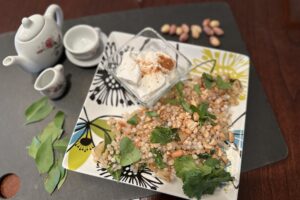Watch Video: “Preparing Dal Dhokli” & on Youtube!
Dal Dhokli is as popular a Gujarati dish as pizza is to Italians. It has a medley of different tastes from sweet and sour to spicy and tangy. This recipe is an entire meal in one dish just like pizza. Dal Dhokli is always a popular dish served for Sunday lunch. It is interesting for my readers to know that in the city of Ahmadabad in Gujarat, the people will just go to famous restaurants just to have Dal. Gujarati people are fond of eating different foods. They are well known for for their taste buds. This plain Dal is a staple meal for all Indian households.
V, J
This is another version of Dhokli.
Same Pasta with long beans and it is yummy.!
Recipe Type: Vegan, Jain
Preparation Time: 10 mi
nutes
Cooking Time: 35 minutes
Serves: 4-6
Difficulty Level: Medium
Utensils needed:
- Rolling pin
- Cutting board or Rolling board
- Knife
- Pressure Cooker (optional)
Ingredients for the Dal:
| 1 | Cup | Toovar Dal or Arhar Dal (Split Pigeon Peas) |
| 1 | Tsp | Salt |
| Few | Curry Leaves | |
| 1 | Tsp | Ginger Paste (optional) |
| 2 | Tsp | Coriander & Cumin Powder |
| 1/4 | Tsp | Turmeric Powder |
| 3-4 | Tsp | Jagri or Molasses or Sugar |
| 1/4 | Tsp | Red Chili Powder |
| 1 | Tsp | Mustard Seeds |
| 1 | Tsp | Cumin Seeds |
| 2 | Small | Cinnamon Sticks |
| 2 | Small | Cloves |
| 1-2 | Small | Whole Red Chili (optional, may be too spicy) |
| Pinch | Astofedia | |
| 1 | Tomato, cubed | |
| 2 | Tsp | Lemon juice or Kokam 3-4 PC |
| 2 | TBsp | Raw Peanuts, Cashews piece & Raisins (optional) |
| 1/2 | Cup | Green Frozen Peas (optional) |
| 2 | TBsp | Oil |
Ingredients for the Dough:
| 1 | Cup | Whole Wheat Flour |
| 1 | Cup | Water |
| 2 | TBsp | Ground Flax Seeds |
| 1 | Tsp | Salt |
| 1/4 | Tsp | Red Chili Powder |
| 1/4 | Tsp | Turmeric |
| 2 | TBsp | Flour to Roll |
| Garnish | Coconut Flakes | |
| Garnish | Cilantro, chopped |
Directions:
- Wash Dal thoroughly and if you have a pressure cooker, cook Dal until it’s done. Otherwise, in a 3 quart sauce pan, boil Dal for 30 minutes on medium heat with 5-6 glasses of water until it is completely cooked.
- Use a hand blender and liquefy the Dal.
- In a bowl, mix the spices and flax seeds and make a soft dough so it is easy to roll.
- Make equal portions of 5-6 rolls. Now it is ready to roll. (Photo above.)
- In a 3 quart sauce pan on medium heat, heat the oil and add mustard seeds, cumin seeds, cinnamon sticks, cloves and a whole red chili pepper.
- As it starts popping, add a pinch of astofedia and pour in liquefied Dal and almost 4 cups of water.
- Let it boil. Once it has boiled, keep 1 cup of the boiled dal aside. (Dhokli tends to absorb water, so this way at a later time one cup of Dal can be added.)
- Use a rolling pin to roll out all of the balls and make a tortilla shape. Roll all of them with the help of powder and sprinkle flour in between the tortillas. Set them aside.
- While Dal is boiling, cut tortillas with a knife into pieces measuring 2 inches by 2 inches.
- Add piece by piece into the boiling Dal. Use all of the rolled tortillas.
- As the Dal with pasta is boiling, add jagri or sugar, salt, chili powder, coriander and cumin powder, lemon juice and turmeric.
- Now you can also add optional items like peanuts or cashews, raisins and/or frozen peas.
- Garnish with ground coconut flakes and chopped cilantro leaves.
Tips:
- Dhokli can be enjoyed as one meal and it can be eaten with rice and papadum.
- It can be garnish with a ripe banana cut into small pieces or with pickles.
- Most of my friends enjoy it with olive oil infused with red chilis.
Enjoy!
<
Natural Benefits and Curative Properties of Split Pigeon Pea
The pigeon pea is easily digested and therefore suitable for invalids. It has many medicinal properties. It relieves inflammation of internal organs. However, excessive use of pigeon pea causes hyper acidity and wind in the intestines. Therefore, it is forbidden in gastric ulcer and heart disease
- Baldness: A fine paste made of this pulse is highly useful in bald patches. It should be applied regularly.
- Jaundice: The expressed juice of the leaves given, with a little salt, is highly beneficial in the treatment of jaundice. 60ml of this juice should be taken daily in this condition.
- Checking Breast Milk Secretion: The pulse and leaves ground into a paste, warmed and applied over the mamma, has the effect of checking the secretion of breast milk.
- Inflammation: The leaves of the plant are effective in all inflammatory conditions. A poultice made with the seeds will also reduce swelling.
- Piles: Paste of the leaves, mixed with a teaspoonful of paste of neem leaves, is highly beneficial in the treatment of piles and itching in the anus. It should be taken once daily for a week.
.








